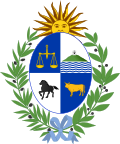Our website is made possible by displaying online advertisements to our visitors.
Please consider supporting us by disabling your ad blocker.
National Anthem of Uruguay
| English: National Anthem of Uruguay | |
|---|---|
 | |
National anthem of Uruguay | |
| Also known as | Orientales, la Patria o la Tumba (English: Easterners, the Fatherland or the grave[a]) |
| Lyrics | Francisco Acuña de Figueroa, 1830 |
| Music | Francisco José Debali, 1845 |
| Adopted | 1833 |
| Audio sample | |
National Anthem of Uruguay | |
| This article is part of a series on the |
| Culture of Uruguay |
|---|
 |
|
Uruguay Portal |
The "Himno Nacional de Uruguay" (English: "National Anthem of Uruguay"), also known by its incipit "Orientales, la Patria o la Tumba" (English: "Easterners,[a] the Country or the Tomb"),[1] is the longest national anthem in terms of duration with 105 bars of music.[2] When performed in its entirety, the anthem lasts about four-and-a-half to six minutes, although nowadays only the first verse and chorus are sung on most occasions,[3] such as before sporting events.
Its martial[4] lyrics were written by the Uruguayan poet Francisco Acuña de Figueroa in 1830, who also wrote the lyrics for Paraguay's national anthem, "Paraguayos, República o Muerte". The lyrics were officially declared the national anthem in July 1833.[5] Several proposed musical settings failed to gain public support.[6] The Rossini-inspired[7] music that eventually became universally associated with the anthem was composed by the Hungarian-born composer Francisco José Debali, with the assistance of Fernando Quijano, a Uruguayan actor and musician.[6] A few days after the first performance in July 1845, Debali's score was officially recognized as the music for the anthem.[8] As with other South American national anthems, the music was inspired by the local popularity of Italian opera.[7] It includes several references to La Cenerentola and other operas by Rossini, as well as a direct musical quotation from Lucrezia Borgia by Gaetano Donizetti.[7]
The French composer Camille Saint-Saëns is sometimes erroneously credited with having composed the music: although he was requested to write a hymn to celebrate the national independence day, his composition never became the national anthem.[9]
Cite error: There are <ref group=lower-alpha> tags or {{efn}} templates on this page, but the references will not show without a {{reflist|group=lower-alpha}} template or {{notelist}} template (see the help page).
- ^ "Eastern landsmen, our country or the tomb! (Uruguay) (arr. P. Breiner) : Uruguay ("Eastern..." YouTube. 24 May 2015. Archived from the original on 2021-12-05.
- ^ Facts About National Anthems National Anthems of the World
- ^ "The World Factbook — Central Intelligence Agency". Archived from the original on 2018-12-23. Retrieved 30 June 2018.
- ^ Cite error: The named reference
Montoro2016was invoked but never defined (see the help page). - ^ Cite error: The named reference
embajadawas invoked but never defined (see the help page). - ^ a b Cite error: The named reference
Panizzawas invoked but never defined (see the help page). - ^ a b c Cite error: The named reference
Gon2013was invoked but never defined (see the help page). - ^ Cite error: The named reference
anthemswas invoked but never defined (see the help page). - ^ Cite error: The named reference
Saint-Saënswas invoked but never defined (see the help page).
Previous Page Next Page


